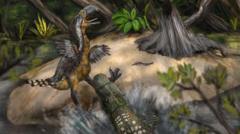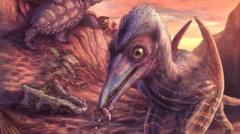Researchers studying a fossilized leg bone of the 'terror bird' in the Tatacoa Desert of Colombia have found teeth marks which suggest this towering avian predator met its demise at the jaws of an even larger caiman, a crocodile-like reptile. According to a study published in the journal Biology Letters, the analysis highlights a rare moment of confrontation between two apex predators around 13 million years ago.
The terror bird stood approximately 2.5 meters tall and was known for its powerful legs and sharp beak, making it a formidable hunter in its swampy habitat. The fossilized leg bone was unearthed more than 15 years ago, yet it is only now that scientists, led by researcher Andres Link from the Universidad de Los Andes, have determined the cause of death through detailed scrutiny of the teeth marks left on the bone.
Employing advanced 3D scanning technology, the research team compared the markings to the skulls and teeth of various crocodile-like predators in museum collections. Their findings indicate that the markings match closely with those of an extinct caiman species, Purussaurus neivensis, which could have reached lengths of up to five meters. This suggests that the caiman ambushed the terror bird, striking from the water’s edge much like modern crocodiles.
While the evidence strongly suggests a deadly encounter, the researchers acknowledged that they cannot definitively conclude whether the bird was killed during the attack or if it was scavenged after its death. Lead researcher Andres Link emphasized that the absence of healing in the bite marks strongly indicates the bird succumbed to its injuries shortly after the incident.
The Tatacoa Desert, known for its rich fossil deposits from the Middle Miocene epoch, has yielded a variety of significant finds, particularly from a time when the region was a lush swamp. The new insights gained from this study underline the interconnectedness of ancient ecosystems and reveal that even the fiercest predators, like the terror bird, had their vulnerabilities.
This discovery not only enriches our understanding of the ecological dynamics of prehistoric Colombia but also underscores the value of fossils in constructing a more holistic view of our planet's history. Dr. Link remarked, “Every piece of a body helps us to understand so much about life on the planet in the past.”

















